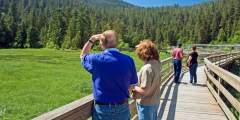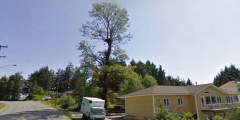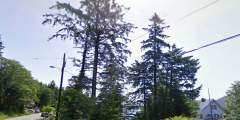Ketchikan Eagle Viewing: 30 Eagle's Nests You Can See
The American bald eagle loves Alaska, with populations so robust that it was never listed as threatened or endangered here. With an estimated 30,000 eagles in the state, it’s easy to spot one of these national symbols, especially in Southeast Alaska.
With wing spans up to 7.5 feet, eagles are powerful, but can only lift 3 or 4 pounds. They don’t seem to know their own limits though. We’ve seen more than one eagle stranded on the beach waiting for its wings to dry so it can fly again (usually after it gets dragged into the water a bit after an unsuccessful attempt to pick up a fish it couldn’t handle.)
Spotting eagles is a highlight of any visit to Alaska. Ketchikan has 30 nesting sites weighing in up to 2,000 pounds and measure 6 feet deep. Eagle's remain in Ketchikan because eagles know they won’t starve here. Eagles are carnivores and live to eat fish, so you’ll see them plenty at the mouth of salmon streams, Ward Cove, Herring Cove, Ketchikan Creek. Salmon pass through the area from April through September. Eagles even hang around in winter; the water remains ice-free, and the fish keep coming.
Visit Ketchikan in May and you’ll start to see mature eagles preparing their nests. Their eggs hatch the following month, and through June and July you can watch adult eagles feeding their young in the nests. From mid-August through early September, the baby eagles are learning how to fly, honing their flying skills and practicing hunting pink salmon. You can see some of this nesting activity from the town’s roads and others from the water.
Eagles are thought to breed for life, and in Alaska can live into their early 30s. The iconic white hood and tail don’t show up for about five years, so if you see one with brown feathers, it’s probably a juvenile. (You can also tell by the beak; young eagles have a black beak that later turns yellow).
You’ll also see eagles hovering around the cannery area and fish-cleaning spots around town. And if you’re walking along coastal areas, look up: eagles will often perch at the very tops of the trees (the higher up they are, the better the vantage point to see fish in the water). In fact, if you know where to look, you can see five to 10 eagles on your own over a day or two. But your chances of spotting eagles increases with the Lighthouse Totems and Eagles Excursion, since their guides know where the eagles have made their nests. On this tour, you may see between 10–20 eagles, making for an unforgettable Alaskan wildlife-spotting experience.
Eagles are resident in Ketchikan at all times of year, but summer is the time to catch them feeding their young and swooping down for salmon. If viewing eagles is one of the highlights of your trip, there are specialized tours that will point out active nests and give you more insight from Ketchikan residents that have been keenly observing the population over the years.
Show Map
Eagles Nests
Just outside Ketchikan, the Alaska Rainforest Sanctuary promises a close-up view of old-growth forest, salmon habitat, an historic lumber mill, totem carving, raptor exhibits, and chances to see black bear and other wildlife – all in under 3 hours! There’s no better introduction to Alaska’s Southeast than this showcase of ecology, wildlife, history and Native culture.
The Ketchikan Regional Youth Detention Center eagle nest is best viewed from two land-based locations. From the north edge of the Public Health parking lot (just north of the Mormon church) look above the left hand peak of the KRYDC. The alternative, and perhaps best viewing, is from the parking lot of Calvary Bible ChurchSize: MediumViewing: Easy
Nordic Tug (a.k.a Longshoreman Dock) Nest is only viewed from the water. Look SE towards the shore to the treetops growing about 100 yards (300ft) up the hill from the N. Tongass Hwy. Look for a cluster of dead Cedar spires. The nest sits among them like a mushroom on a shish-kabob! Size: Medium-SmalViewing: Moderately Difficult
The Dawson Point eagle nest is best viewed from the water just north of East Island near the NW entrance of Ward Cove. Locate a single thin snag on the right hand end of the Dawson Point skyline. Count 4 trees to the left. This is a large pyramid shaped dark green Sitka spruce with a flat notch near the top right side. Adults & chicks can be seen in season. Size: MediumViewing: Moderate
Saxman Nest can be seen seaward & slightly south of the City Hall parking lot just off the South Tongass Hwy. Look for this nest in a deciduous tree, which is rare for the area. Eagle’s usually don’t nest in deciduous trees! Size: Medium-LargeViewing: Easy
Valley Park School eagle nest is on the hillside to the east. Pull into the parking lot and park close to the fire hydrant. Look above the right hand end of the dugout on the baseball field until you locate a large dead snag. Size: Medium-LargeViewing: Easy
Mecca Eagles Nest is a challenge to find from land or water. It is in a low-lying treetop above a waterfront brown home with brown roof. By land, turn seaward off the north Tongass Hwy, one driveway north of the Mecca at 11.3 mile NT. The nest can best be found during incubation and active feeding times when the white head of the adult eagle will show you this nest. Size: SmallViewing: Challenging ...more
Ward Cove Eagles Nest is in the western bight of Ward Cove, which is north of Ketchikan. It is located above the center of the western bight shoreline and can be best viewed from near the point. Look for a tall dead tree top about half the way up the steep hill side from the vicinity of this location. The nest is just below the dead section and on the left. Size: Medium-Large Viewing: Moderate ...more
At the Eagle Center, you can get up close to 10 rescued birds, including a golden eagle, great-horned owls and even a turkey vulture. One pair of bald eagles has mated for life and occasionally has babies to show off. Phone: 800−252−5158, 907−228−5530. Hours May-Sep: 8am‑4:30pm (daily) Winter: By appointment Admission $10/adult, $5 kids ages 2 – 11. ...more
Ready Mix Eagle Nest is equally seen from both the water and land. By land, turn west off of N. Tongass just north of Ketchikan Ready Mix & Quarry. Park or stand between the two picnic benches and look back over the cliff above the highway. The nest is in a huge treetop near the crown of a skyline prominent tree. You can see the nest by boat from a variety of angles.Size: HugeViewing: Easy ...more
Fawn Mountain School eagle nest is best seen from the school’s access road as you turn left off the South Tongass Hwy and head up the hill towards the school. Pull off the road to the left on the driveway. Look about 25 feet down from the top of the large Sitka Spruce tree to your southeast.
The Shoreline Nest is best viewed from land by turning off North Tongass Hwy at the north entrance to Shoreline Drive. When you are around address 5306, look seaward to the nest, which sits about 1⁄3 of the way down from the top of a tree. Size: Medium-SmallViewing: Easy
Danger Island is located west of Refuge Cove & north of Channel Island in the Tongass Narrows just north of Ward Cove. The Danger Island eagle nest is located under the crown of an umbrella-shaped tree at the point of where the trunk splits. It is best viewed from northwest of the island. Size: LargeViewing: Easy
East Clump is an island at high tide directly across Tongass Narrows from the south end of Bar Harbor near Madison Lumber. The nest tree is on the south edge of East Clump and best viewed from the water.Size: MediumViewing: Moderate
Mountain Point eagle nest is located near a side road just north of the Mountain Point boat ramp. As you are traveling south on the South Tongass Hwy, slow down as you pass the Mt. Pt. Maritime marker. Turn left onto the side road at the 35 MPH + curve sign. Pull off this road on the left into a quarry type area about ½ block from the highway and look north-northwest to a large Sitka Spruce.Size: MediumViewing: Medium ...more
South Tongass Fire Department eagle nest can be seen from the parking lot by their old fire station off of South Tongass Highway, just south of the Mt. Pt. Boat launch. Check the largest Sitka Spruce in the stand of timber above the electrical substation and you’ll see the nest about 30 feet from the top. Size: MediumViewing: Moderate
The McClennan eagle nest is best viewed from the water north of Totem Bight State Park from a point in front of the Mickel home (gray with white trim). The nest is on the right hand side of a huge old-growth tree where the longest branch is attached, well below the lopped off top. This tree rises above the McClennan home. Size: Medium-LargeViewing: Medium-Easy
Long Island, owned by Tim & Kay Long, is located south of Refuge Cove State Park and west of Refuge Cove Marina, about 8 ½ miles north of Ketchikan. The Long Island eagle nest is best viewed from the southwest side of the island by looking 1⁄3 the way down from the top of the largest tree on side of the island that you’re facing. Size: MediumViewing: Moderate
The nesting pair have built a new nest just north of McClennan’s house on the point and near the water’s edge. It is very near the top of the tallest tree among the short immature spruce that grow there. Size: Small (but it makes the EALGES look biiiiigger!) Viewing: EasyDon’t spend so much time on the eagles that you miss the whales .…… BEHIND YOU!
The Lama Head eagle nest can be viewed from the water. Look for a round gray boulder on the beach near the high tide line. Now let your eyes sweep about 35 feet to the right along the beach and then strait up to the treetops. If you look closely you’ll see the shape of a Lama in the trees. Look for the Lama’s long skinny neck, pointed nose to the left, peaked ears and a packsaddle. What you perceive to be a packsaddle IS the eagle’s nest.… ...more







